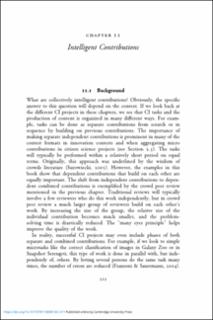| dc.contributor.author | Baltzersen, Rolf K. | |
| dc.date.accessioned | 2022-09-25T23:33:47Z | |
| dc.date.available | 2022-09-25T23:33:47Z | |
| dc.date.issued | 2022 | |
| dc.identifier.uri | https://hdl.handle.net/11250/3021118 | |
| dc.description | Chapter 11 in Cultural-historical perspectives on collective intelligence
In the era of digital communication, collective problem solving is increasingly important. Large groups can now resolve issues together in completely different ways, which has transformed the arts, sciences, business, education, technology, and medicine. Collective intelligence is something we share with animals and is different from machine learning and artificial intelligence. To design and utilize human collective intelligence, we must understand how its problem-solving mechanisms work. From democracy in ancient Athens, through the invention of the printing press, to COVID-19, this book analyzes how humans developed the ability to find solutions together. This wide-ranging, thought-provoking book is a game-changer for those working strategically with collective problem solving within organizations and using a variety of innovative methods. It sheds light on how humans work effectively alongside machines to confront challenges that are more urgent than what humanity has faced before. This title is also available as Open Access on Cambridge Core. | en_US |
| dc.description.abstract | Chapter 11 address how contributions are combined in different ways when designing CI. One approach utilize many different perspectives on the same work, like in collective work on the same Wikipedia article. Multidisciplinary innovation teams also include a diversity of perspectives in creative problem solving. Second, contributions can be combined under the assumption that the golden middle way is the best solution. One example is the identification of a quantitative middle point, such as an average, that provide the most accurate solution if contributions are diverse. Another strategy is to find the middle way by developing a balanced representation of all sides like in collective argument mapping. In addition, the middle way can identify commonalities, like the online environment vTaiwan that let the crowd find consensual statements in political conflicts. A third approach scales up the number of contributions in the search for an unexpected solution. Many breakthrough ideas happen at the outskirts of a field. Online innovation contests aim to bring in creative outsiders or unknown others by inviting anyone to join. Furthermore, most of the contributions in CI-projects build on a modularization strategy that split a complex challenge into many smaller subtasks. | en_US |
| dc.language.iso | eng | en_US |
| dc.publisher | Cambridge University Press | en_US |
| dc.rights | Attribution-NonCommercial-NoDerivatives 4.0 Internasjonal | * |
| dc.rights.uri | http://creativecommons.org/licenses/by-nc-nd/4.0/deed.no | * |
| dc.subject | Collective intelligence | en_US |
| dc.subject | Reputation society | en_US |
| dc.subject | Online reputation | en_US |
| dc.subject | Reputation score systems | en_US |
| dc.subject | Social media | en_US |
| dc.subject | Informal assessments | en_US |
| dc.subject | Social comparison | en_US |
| dc.subject | Evaluating the collective work | en_US |
| dc.subject | Metacommunication | en_US |
| dc.subject | Shared coordination | en_US |
| dc.subject | Coordinators | en_US |
| dc.subject | Critical discourse | en_US |
| dc.subject | Institutionalization | en_US |
| dc.subject | The nomothetai | en_US |
| dc.subject | Citizen evaluation | en_US |
| dc.subject | The Citizen´s Assembly in Ireland | en_US |
| dc.subject | Metadiscourse | en_US |
| dc.subject | Knowledge Commons | en_US |
| dc.title | Intelligent Evaluations | en_US |
| dc.type | Chapter | en_US |
| dc.description.version | publishedVersion | en_US |
| dc.rights.holder | Rolf K. Baltzersen | en_US |
| dc.source.pagenumber | pp 340-365 | en_US |
| dc.identifier.doi | 10.1017/9781108981361.012 | |

